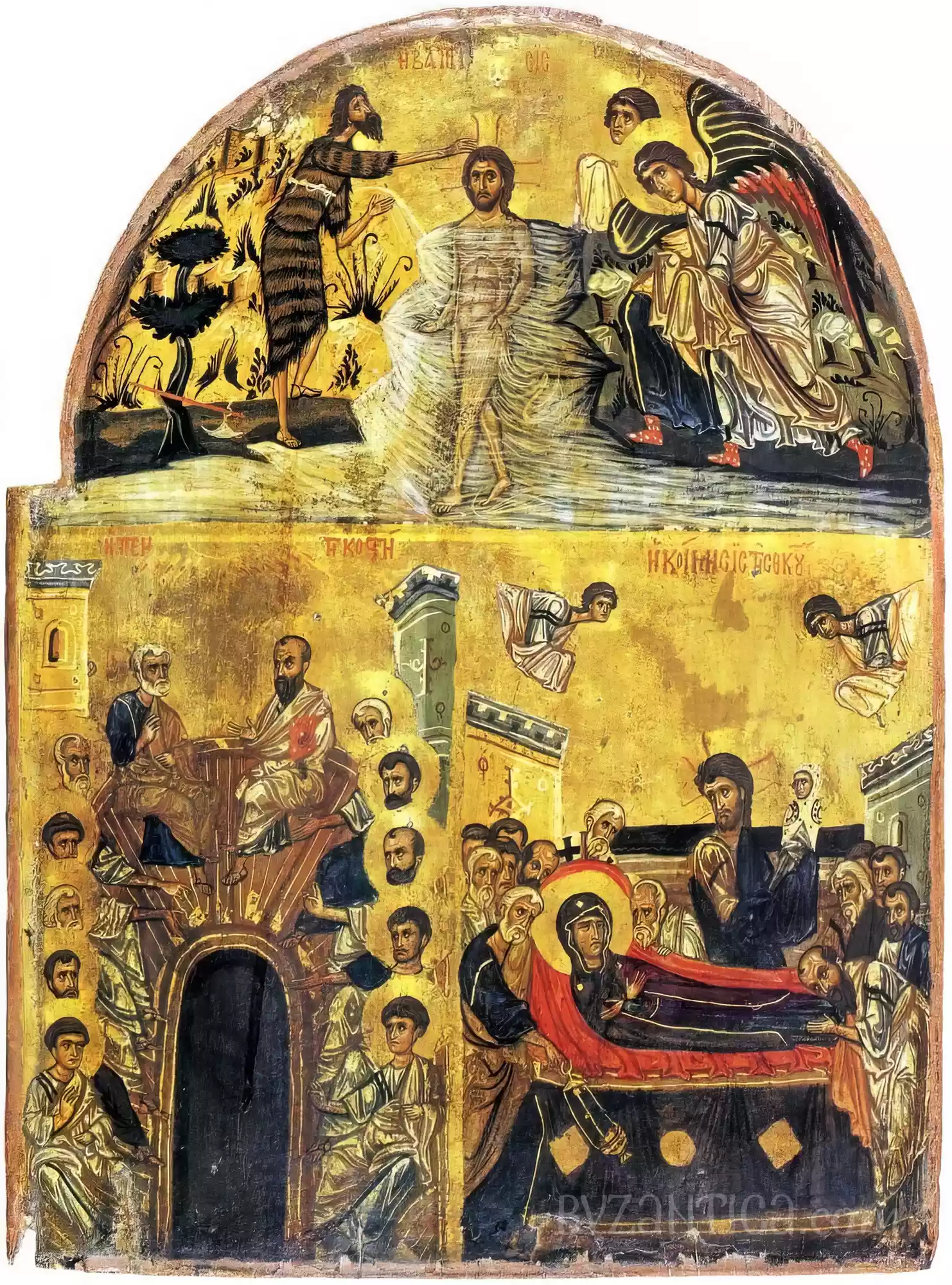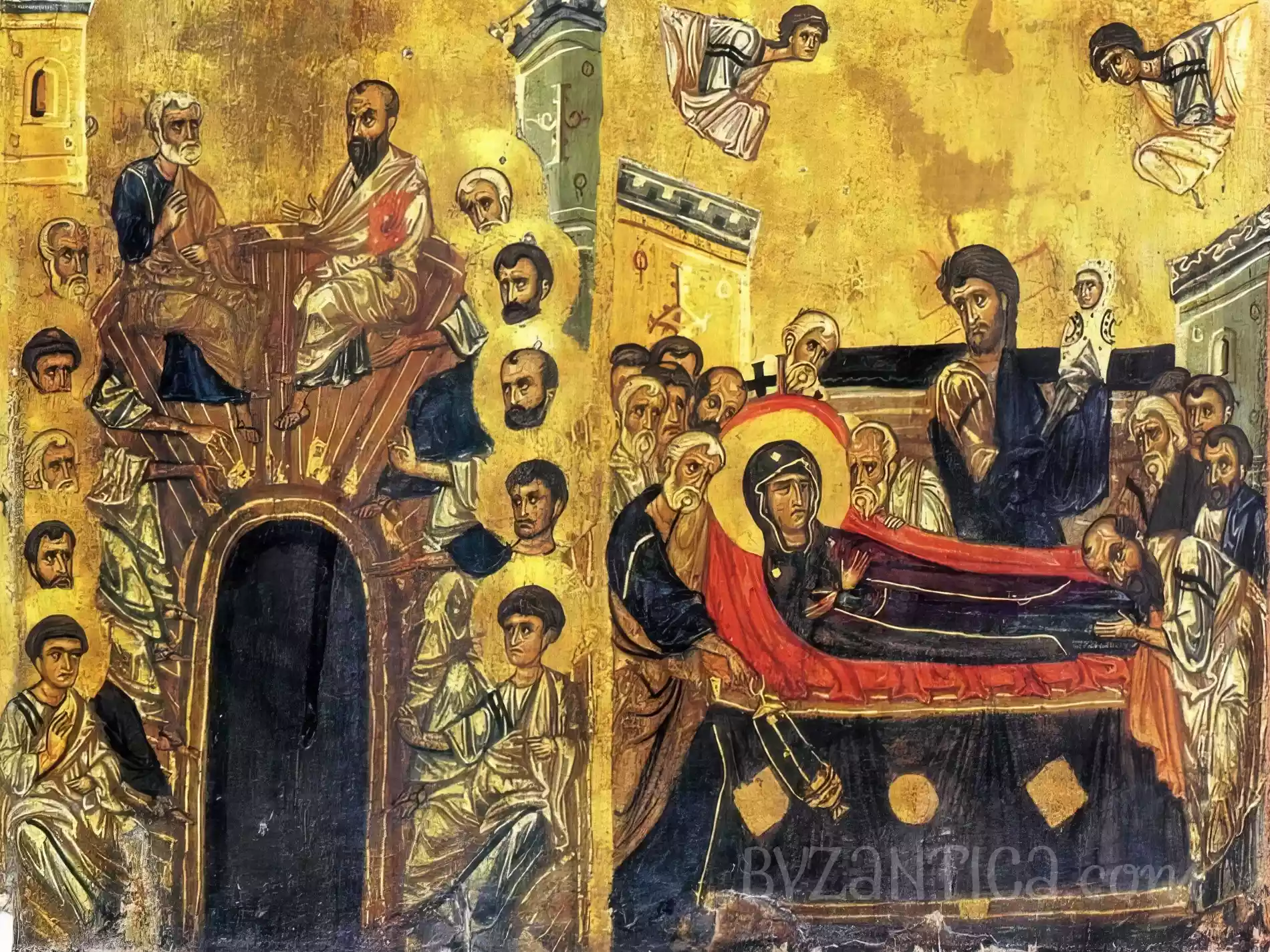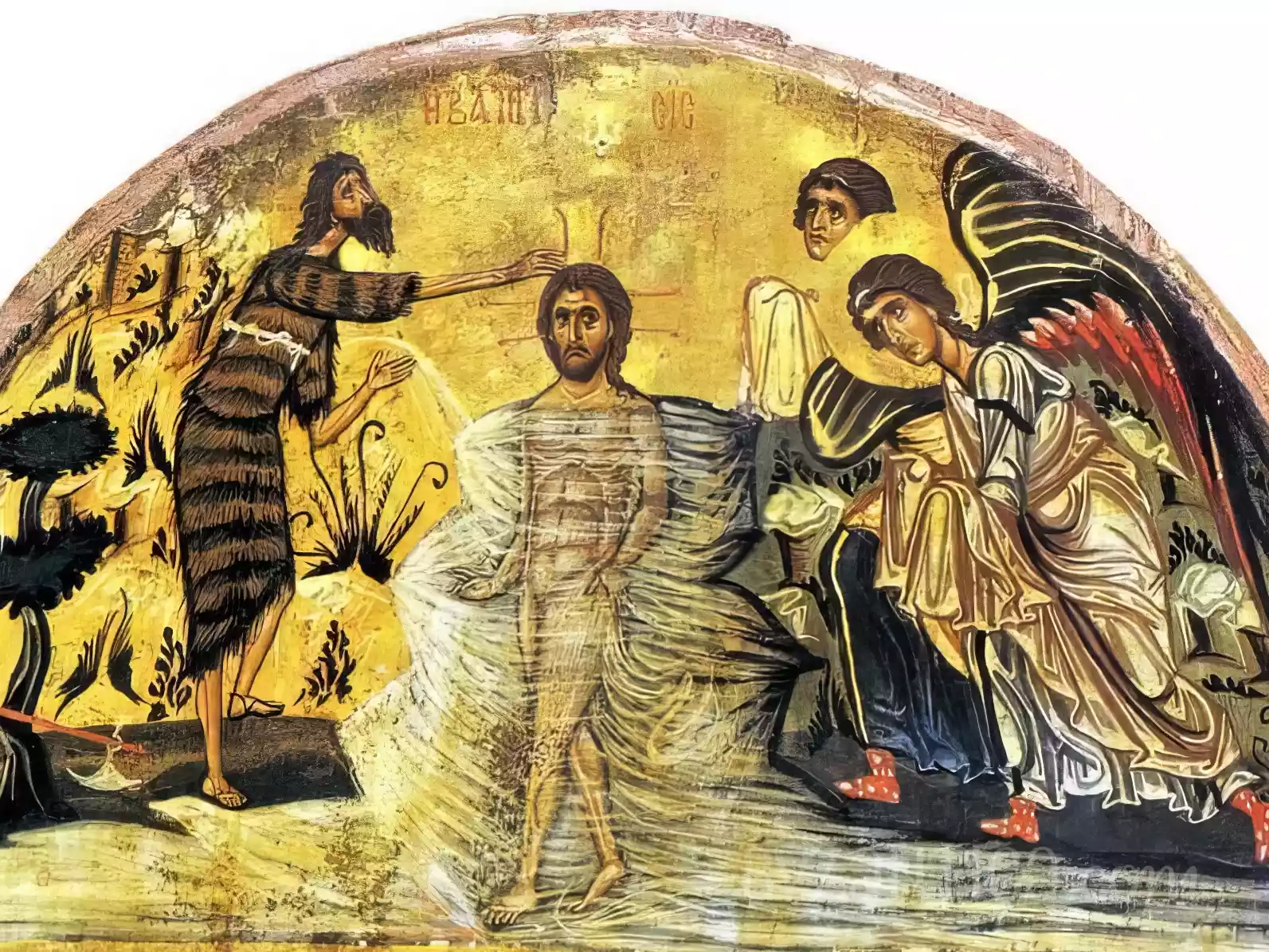Tetraptych Dodekaorton at Sinai
Title: The Baptism, Pentecost and Dormition of the Virgin Tetraptych Panel
Artist Name: Unknown Master of Sinai
Genre: Religious Icon
Date: Second Half of 12th Century AD
Materials: Egg tempera and gold leaf on wood panel
Location: Saint Catherine’s Monastery, Sinai, Egypt
The Sacred Geometry of Divine Revelation
The sacred panel unfolds before me like a window into heaven itself. Gold leaf bathes the surface in divine light, creating a supernatural realm where time stands still. Each scene pulses with spiritual energy, arranged in a careful hierarchy that draws the eye upward from earthly to celestial planes.
In the upper register, Christ’s Baptism commands attention through its stark simplicity. John the Baptist extends his hand in blessing, his rough garment contrasting with Christ’s luminous form. Angels bow in reverence, their wings catching golden highlights. The composition achieves perfect balance through asymmetry – the stark figure of the Baptist on the left offset by the clustered angels on the right.
The panel’s lower register tells multiple stories through masterful spatial organization. Densely populated scenes flow into one another yet remain distinct through architectural elements and subtle shifts in scale. The artist’s hand moves with confident precision, laying down rich colors that still glow with intensity after nearly nine centuries. Each face exhibits individual character while conforming to iconic types – a testament to the unknown master’s ability to work within tradition while bringing scenes to vivid life.
As noted by Maria G. Parani in her analysis of Byzantine artistic conventions, such iconic representations served not merely as decoration but as windows into divine truth. The careful arrangement of figures and architectural elements creates clear theological narratives while maintaining artistic sophistication.
The Tetraptych Dodekaorton at Sinai: Sacred Narratives Unveiled
The second scene draws us deeper into the mystical narrative. As Ľubomír Blišák notes in his study of sacred monuments, such artistic arrangements served to preserve and transmit profound theological truths.
The central figure of Christ dominates through subtle mastery rather than overwhelming presence. His garments shift between earthy browns and celestial whites, creating a visual bridge between human and divine realms. The artist’s hand moves with exceptional control – each fold of drapery carries meaning, each gesture speaks volumes in the sacred visual language of icon painting.
What strikes me most is the masterful handling of architectural elements in the lower register. Buildings frame and segment the narrative while creating depth through their precise geometric forms. These structures aren’t mere backdrops – they actively participate in the theological messaging. Golden highlights pick out key architectural details, drawing the eye through the composition with thoughtful purpose.
The faces of the gathered figures reveal remarkable individuality despite their adherence to iconic types. Helen C. Evans has highlighted how Saint Catherine’s Monastery preserved such artistic treasures, allowing us to witness this delicate balance between tradition and innovation. The unknown master’s brush brings each character to life through subtle variations in expression and pose.
Particularly moving is the treatment of the Virgin in the Dormition scene. Her peaceful repose contrasts with the dynamic poses of the surrounding apostles. The artist employs a sophisticated understanding of perspective, using architectural elements to frame the scene while creating an intimate sacred space. The deep blues of the Virgin’s garments anchor the composition, while touches of vermillion and gold create points of spiritual radiance throughout.
This panel stands as a testament to the profound artistic and spiritual achievements of 12th century Byzantium. Every brush stroke serves both aesthetic and theological purposes, creating a work that continues to speak across centuries.
Beyond Visual Narratives in Byzantine Religious Art
We have to take into account how this tetraptych fits Byzantine religious knowledge going beyond simple visual description. The gold backdrop serves not only for decoration but also for a timeless, holy environment where divine secrets play out. By means of deliberate attention to composition, colour, and symbolism, the undiscovered master has produced a masterpiece beyond its function as mere decoration.
Red underpaintings show themselves in areas, generating subdued warmth that contrasts with the chilly blues of shadows. This technical complexity reveals the artist’s command of materials. Every stroke seems intentional yet natural, creating formations between the physical and spiritual spheres. The faces especially show this dual nature: they keep distinct character while yet fitting famous forms.
The architectural features call for particular notice. Far from basic backgrounds, they construct meaningful environments that lead the sight and thought across the holy tale. Arches and columns set hierarchy and frame events. The composer divides and unites the work using these structural devices, hence generating rhythmic movement between scenes.
The way this strikes a mix between artistic innovation and legacy makes this really intriguing. The artist offers fresh vitality by minute changes in posture, gesture, and emotion even while she follows accepted iconographic rules. Though their hieratic structure, the collected figures seem alive. Their clothes flow effortlessly and yet have symbolic meaning.
Suggesting supernatural illumination, light plays over surfaces in ways that seem to go beyond physical rules. Gold draws attention to key elements – a gesture here, a fold of draperies there – so establishing visual channels through the piece that reflect spiritual development. The whole impact informs viewers that they see everlasting truths rather than only historical happenings.
The Sacred Assembly: Detail Analysis of the Lower Register
This lower register detail deserves close study since it shows the artist’s deft management of architectural space and figure groups. Clustering around an arched gateway, the gathering apostles move across the golden ground in time with their gestures and expressions. How does the artist keep visual harmony while yet expressing so great spiritual gravity?
The figures wear robes in warm earth tones and deep blues; their folds are accentuated by strong brushstrokes suggesting volume without sacrificing the required flatness of the emblem. Every face reveals unique personality; note particularly the difference between the younger, beardless apostles and their older friends with flowing white beards. Still all uphold the formal dignity demanded by the holy subject.
One should pay especially attention to the architectural environment. The dark opening of the arched gateway creates dramatic contrast with the dazzling gold backdrop, therefore acting as both compositional anchor and metaphorical portal. Above, little building details float against the gold ground, their exact geometric forms balancing the organic curves of the figures below.
One finds remarkable how the artist manages perspective. Multiple points of view are used to establish a holy realm that transcends physical reality instead of rigorous linear perspective. With their slanted angles generating dynamic energy while preserving iconic flatness, the building parts seem to float between material and spiritual worlds.
Most moving is the respectful attention of the assembled gathering. The artist generates a strong sense of spiritual expectation by varying subtly the posture and gesture. The music invites us into this holy moment while preserving suitable distance; we see but cannot completely access these divine secrets.
Light and Shadow: The Baptism Scene Analysis
In Christian theology, this higher register detail catches a turning point. The arched structure of the piece establishes a holy place where earthly and divine domains interact. The way Christ’s primary figure is handled masterfully in mild, radiant tones that seem to exude light from within makes first impression.
John the Baptist, dressed in striped clothing, reaches out his hand towards Christ in a sign both blessing and acknowledgement. His austere look contrasts sharply with the graceful angels on the right, their wings selected in bright reds and whites against the golden ground. Their attitudes imply respect and protection as well.
The way the artist treated Christ’s clothing reveals her technical ability. Fine white lines produce subdued modelling implying both physical form and spiritual brightness. The brushwork stays exact but flowing, balancing iconic rigidity with spontaneous movement. Dark outlines clarify forms without growing mechanical or stiff.
The asymmetrical balance of the composition has great power. The clustered angels on the right balance the Baptist’s angular, austere form on the left. Christ is the still point between these active components; his posture suggests both divine power and human fragility at once.
The way the artist manages the golden background is quite amazing. It seems to pulse with spiritual energy instead of being a flat surface, adding depth by minute changes in tone and texture. While preserving its mysterious aspect, small architectural and landscape components – stylised rocks and trees – link the image in terrestrial reality.
Theological Dimensions and Cultural Context
More than just artistic success, the Tetraptych Dodekaorton at Sinai reflects difficult spiritual truths in visual language. Theological program runs with great accuracy, each scene building on the next to produce a whole story of salvation history.
Especially worth thorough theological study is the Baptism scene. Bathed in divine light, Christ’s centre posture reflects the Orthodox interpretation of theophany, the disclosure of God’s nature via physical form. Reflecting Orthodox instruction on the hypostatic union, the treatment of Christ’s body finds a careful balance between human and divine natures.
The way John the Baptist positions and gestures have several theological connotations. His uplifted hand points and blesses at once to name Christ as the expected Messiah. Emphasising his position as the last prophet of the old covenant and first witness of the new, his austere life is recalled in his clothing’s simplicity.
The angels bring still another religious depth. Their bent in respect but eager for service shows the Orthodox interpretation of angelic ministry. Picked out in bright reds against the golden landscape, their wings imply their function as middle ground between heaven and earth.
The work itself teaches Orthodox theology. Christ’s centre axis runs like a visual metaphor for divine condescension: God bending to join human history. Far from just decoration, the golden background stands for divine light filling creation. The position of every figure in respect to this gold ground reveals their interaction with heavenly reality.
Especially noteworthy is the artist’s treatment of space. The scene uses what can be called theological perspective – spatial relationships decided by spiritual rather than physical proximity to Christ, instead of naturalistic viewpoint. This method exactly fits the focus on divine immanence and transcendence of Orthodox theology.
Little details have great meaning. The water’s treatment symbolises both washing and tomb, therefore linking Christ’s baptism to his death and resurrection; the stylised rocks and flora represent paradise restored through baptism. Such graphic theology shows the complex fusion of creativity and ideology unique of Byzantine holy work.
Legacy and Reflection: The Tetraptych’s Enduring Voice
Standing before the Tetraptych Dodekaorton at Sinai, I discover myself engaged in a centuries-long visual conversation. Over time, the artist’s talent creates a bridge between earthly and celestial worlds that still moves viewers now. How might this holy artwork keep communicating across chronological and cultural borders?
Time seems to pass differently here. Hallowed.
Together, gold and colour, the precise balance of form and spirit, the deft handling of religious ideas through visual means – all these components produce something transcendent. Understanding both artistic legacy and spiritual truth, the unnamed master who produced this tetraptych combined them into a whole that still inspires and teaches.
Examining this outstanding work helps us to understand not only Byzantine creative methods but also the very essence of holy art itself. The Tetraptych Dodekaorton shows how paints, gold leaf, oak panels – materials – may be turned into vehicles for heavenly truth. From the instantly obvious story components to deeper religious symbolism encouraging further contemplation, every scene has several layers of meaning.
This artwork is evidence of the continuing ability of Byzantine holy art to communicate across centuries, civilisations, and customs. Its visual language is still strong; its spiritual message is unchangeable with time. In our modern society of transient pictures and instantaneous communication, such consistent artistic excellence provides a great reminder of art’s ability to reflect and express everlasting truths.
The Anonymous Master of the Sinai Tetraptych
The identity of the artist who created the Tetraptych Dodekaorton remains unknown, though their masterful technique speaks of extensive training in Constantinople’s artistic traditions. Working in the second half of the 12th century AD, they demonstrate complete command of both theological symbolism and artistic execution.
Working within Byzantine icon painting’s accepted standards, this unnamed master gave conventional scenes new energy. Their unique approach is evident in the way draperies are handled, the sensitive facial modelling, and the clever architectural framing and organisation of compositions. They used gold leaf with amazing ability and understood how to layer paint to produce brilliant effects.
The best successes of middle Byzantine painting are embodied in the artist’s work. Among the best artists of their day, their mastery of colour, knowledge of holy geometry, and capacity to generate spiritual presence by tangible means set them apart. Through this outstanding work, their artistic expression resonates clearly across decades even though we would never know their name.
© Byzantica.com. For non-commercial use with attribution and link to byzantica.com
The analysis presented here reflects a personal interpretation of the artwork. While based on research and scholarly sources, art interpretation is subjective, and different viewers may have varied perspectives. These insights are meant to encourage reflection, not as definitive conclusions. The image has been digitally enhanced. The article’s content is entirely original, © Byzantica.com. Additionally, this post features a high-resolution version of the artwork, with dimensions exceeding 2000 pixels, allowing for a closer examination of its details.
Bibliography
Blišák, Ľubomír. Volunteer Project to Preserve the Cultural Monument of Church and Monastery of Saint Catherine.” European Journal of Science and Theology (2016).
Evans, Helen C. Saint Catherine’s Monastery, Sinai, Egypt: A Photographic Essay. 2004.
Parani, Maria G. “Byzantine Cutlery: An Overview.” Δελτίον της Χριστιανικής Αρχαιολογικής Εταιρείας (2010).
MLA Citation
Georgiou, Kostas. “Tetraptych Dodekaorton at Sinai: Sacred Imagery.” Byzantica, 22 Jan. 2025, www.byzantica.com/tetraptych-dodekaorton-at-sinai-sacred-panels.



